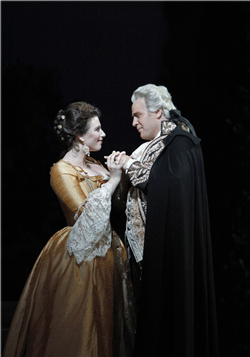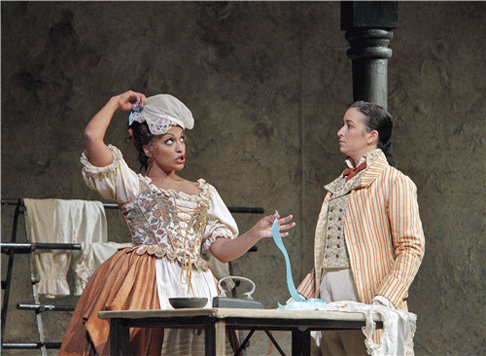11 Oct 2010
Marriage of Figaro in San Francisco (and Los Angeles)
No question that Nicola Luisotti is a conducting genius, and no question that genius runs amuck from time to time. In the case of Mo. Luisotti fairly often.

No question that Nicola Luisotti is a conducting genius, and no question that genius runs amuck from time to time. In the case of Mo. Luisotti fairly often.
The September 23 performance teetered on the edge of madness with the overture used as a projectile to ignite the eighteenth century social unrest that is Le nozze di Figaro. The unrest was not only social, it was also musical for the porcelain-like figurines who embodied Mozart’s by now mythical characters. Their struggle, usually successful, to keep apace with the musical force was heroic, with even unexpected fruits — beautiful agogic accents occurring when a voice fell slightly behind the beat.
If Mo. Luisotti unabashedly strives for effect, its motivation is musical and not mere showmanship. The maestro here met his match in the case of his Susanna, Danielle de Niese and his Figaro Luca Pisaroni, the play of tempos with vocal line was even sublime. The exposition of the story in the first scene was a masterpiece.
 Ellie Dehn as the Countess and Lucas Meachem as the Count
Ellie Dehn as the Countess and Lucas Meachem as the Count
John Copley staged the opera. Mr. Copley is the most musical of directors, merging word and vocal line with movement in perfect concert with storytelling. It is manifest in continuous movement and dramatic flow which was exemplary Copley in the performances of this Susanna and Figaro. Indeed throughout much of the first act and with all of the cast a sense of uneasy perfection prevailed amongst pit, voice and stage.
The maestro’s illumination of musical line and the visual artifice supplied by Mr. Copley created the abundance of detail that resulted in the figurine quality of the cast. Gracefully dominated on September 23 by Mlle. de Niese and Mr. Pisaroni it was otherwise an ensemble cast of gifted singing actors — Michèle Losier as Cherubino, Lucas Meachem as the Count and Ellie Dehn as the Countess, with grand, experienced performances by Catherine Cook as Marcellina, John Del Carlo as Dr. Bartolo and Greg Fedderly as a stylistically exact Basilio.
The sense of exquisite detail that prevailed extended to the smallest roles — a rashly drunk Antonio sung by Bojan Knezevic and the Don Curzio sung by Robert MacNeil.
All this surface artifice played against a vaguely house-like wooden structure that was vaguely indoors/outdoors as needed, and it could also be used for Barber and Falstaff or Turn of the Screw for that matter (best not to mention this to SFO MBA David Gockley). It was built in 1982 for another director and already once visited by Mr. Copley before being taken over by legendary Susanna, Graziella Sciutti turned stage director. Surely it will now go directly from the War Memorial to the dump.
Mo. Luisotti exposed very nimble fingers at the continuo fortepiano, and nimble musicality superimposing a bit of Lohengrin, snatches of Mozart piano sonatas plus a touch of Eine kleine Nachtmusik (and who knows what else) from time to time. Everyone was having so much fun that when things got serious things fell apart. The second part (the third act) brings the big showpiece arias that require big artists to command big theaters. It was beyond the scope of this fine cast who had so brilliantly executed the ensembles of the first part (acts one and two).
 Danielle de Niese as Susanna and Michèle Losier as Cherubino
Danielle de Niese as Susanna and Michèle Losier as Cherubino
To the delight of everyone the maestro and the director exploited the agility of this responsive cast to the degree that when Count Almaviva knelt to beg forgiveness we all laughed because we were so used to being amused by the musical and physical antics. Of course this moment is deadly serious, and after the fact the maestro did try to save the day by imposing a sudden largo. It was too much too late.
After its Ring cycle last spring Los Angeles seemed like the big time, operatically speaking. Its concurrent (to San Francisco) Marriage of Figaro has confused this perception. Seen October 6 three new cast members (Susanna, Marcellina and Barbarina) were being integrated into the cast. This situation alone was sufficient to distort its staging rhythm.
The Marriage of Figaro is central to the repertory of all opera companies. In 2004 L.A. Opera unveiled this Ian Judge production (in its initial years L.A. had relied on the Peter Hall production from Chicago). Now six years later the Judge production still passes as a contemporary statement, needing only a cast and conductor to bring it alive.
Designed by Tim Goodchild (a Brit with extensive theater credentials, like Mr. Judge) it is business like — a back wall of a different saturated color for each scene, a few chandeliers coming and going, and sensibly enough a house on an horizon (like TV’s Dallas) overlooking an extensive dark park illuminated by a huge moon (yes, it is very Halloween though surely this is not its intention).
The costumes, designed by Diedre Clancy, another of our mainstream British cousins, made up in slickness what they may have lacked in inspiration. Clever and surprisingly harmonious was the mix of styles and periods. Not to mention Mr. Judge’s tricky use of a telephone in the Countess’ bedroom and flashlights in the garden in this predominantly period production.
All this high style was not requited by either the conducting or the singing. Placido Domingo was in the pit, by now a very beloved L.A. personage it seems judging from the huge ovation awarded him. In the first part (acts one and two) he imposed tempos that were quite convenient for the singers but lacked the Mozartian impudence that keeps Figaro forever alive.
If the first part of Figaro is about Mozart the second part (acts three and four) is about singers as each are awarded a showpiece aria. Here Domingo was right on with the evening’s stars — Bo Skovhus as the Count and Martina Serafin as the Countess — giving them everything they needed to tear up the stage. And that they did, Mr. Skovhus, though small of voice managed some elegant musicianship rushing back and forth across the stage. Mme. Serafin, of big, very big voice, musically well controlled to be sure was a far more determined Countess than a reflective one (after all la Serafin is usually a Tosca).
These larger scaled performances established an emotional focus for Mozart’s comedy that brought to mind the silly notion that The Marriage of Figaro is the perfect opera. But to subvert any attempt at a perfect realization L.A. Opera succumbed to the too prevalent practice of sending boys in to do men’s work, i.e. expecting talented young singers from an apprentice artist program to embody important Mozartian personalities, and otherwise entrusting character roles to unseasoned artists.
Rebekah Camm gave a fine performance as Susanna, though she does not look like a typical Susanna, and as well she was stepping into a part already staged for another singer (Marlis Petersen sang the first three performances). Daniel Okulitch fulfilled the basic needs of the Count’s major factotum without imparting grand personality and Renata Pokupic made a convincingly adolescent Cherubino.
On October 10 San Francisco Opera introduced four new singers into the last three of its nine performances of Le Nozze — Kostas Smoriginas as Figaro, Heidi Stober as Susanna, Trevor Scheunemann as Almaviva and Dale Travis as Bartolo.
For messieurs Scheunemann and Travis the transition was seamless, both artists blending into the ensemble and upholding its precision. Mr. Smoriginas and Mlle. Stober introduced their own particular tonalities. Both are very warm performers with strong voices, who found themselves at odds with the maestro in the opening scene. A compromise seemed to be reached soon enough resulting in convincingly human performances from these two artists that took the Copley production to another level.
In the end we still did laugh when the Count knelt to beg the Countess’ forgiveness, but in this performance Mo. Luisotti grasped the depth of meaning in this gesture, and infused a warmth and understanding into Mozart’s music that exponentially complicated the situations of the four sets of lovers lined across the stage. This unexpected realization spread slowly through the audience as the last ensemble unfolded, leaving us again smitten by this astonishing work of art.
Michael Milenski
Los Angeles Cast:
Figaro: Daniel Okulitch; Susanna: Rebekah Camm; Count Almaviva: Bo Skovhus; Countess Almaviva: Martina Serafin; Cherubino: Renata Pokupic; Marcellina: Tracy Cox; Doctor Bartolo: Alessandro Guerzoni; Don Basilio: Christopher Gillett; Antonio: Phiilip Cokorinos. Conductor: Plácido Domingo. Director: Ian Judge. Scenery Designer: Tim Goodchild. Costume Designer: Deirdre Clancy. Lighting Designer: Mark Doubleday. Choreographer: Sergio Trujillo